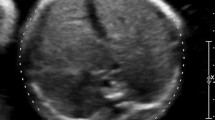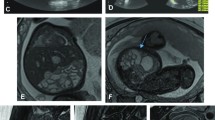Abstract
Objective
Present challenges are to improve the diagnosis rate of oesophageal atresia (OA) and evaluate as completely as possible a fetus affected by OA, specifically the type of OA and the length of the gap. Our aim was to evaluate the accuracy of fetal MR imaging (fMRI) for diagnosis of OA.
Methods
We reviewed fMRI performed because of sonographic suspicion of an OA. The signs reviewed included stomach size, “pouch sign”, bowing of the trachea and visualization of the lower oesophageal lumen. The fetuses were assigned by consensus as having or not having EA, as well as having a tracheaoesophageal fistula (TOF). All findings were correlated with postnatal data. Sensitivity, specificity, positive predictive value (PPV) and negative predictive value (NPV) were calculated.
Results
Se, Sp, PPV and NPV of the technique were respectively 91 %, 100 %, 100 % and 88 %. The presence of the pouch sign yielded corresponding values of 82 %, 100 %, 100 % and 78 %. Mid-tracheal bowing was correlated positively with EA. The type of atresia was correctly evaluated in 90 % of patients.
Conclusion
fMRI is useful for the diagnosis of EA through the visualization of the oesophageal pouch or through associated signs such as tracheal bowing. Visualization of the lower oesophageal lumen seems to be a good sign of TEF.
Key Points
• Challenges are to improve the prenatal diagnosis of EA and associated malformations.
• fMRI is able to diagnose EA through demonstration of the pouch sign.
• Tracheal bowing is a promising indirect sign of EA.
• Tracheoesophageal fistula can also be suspected thanks to fMRI.
• Obstetrical US, fMRI and fetal CT are complementary for assessing associated malformations.






Similar content being viewed by others
Abbreviations
- CCAM:
-
Congenital cystic adenomatoid malformation
- EA:
-
Oesophageal atresia
- fMRI:
-
Fetal MR imaging
- fCT:
-
Fetal CT
- GW:
-
Gestation week
- IAC:
-
Interatrial communication
- IVC:
-
Interventricular communication
- NPV:
-
Negative predictive value
- PPV:
-
Positive predictive value
- TEF:
-
Tracheoesophageal fistula
- TGV:
-
Transposition of great vessels
References
Spitz L (2006) Esophageal atresia. Lessons I have learned in a 40-year experience. J Pediatr Surg 41:1635–1640
Vogt E (1929) Congenital esophageal atresia. AJR 22:463–465
Ladd WE (1944) The surgical treatment of esophageal atresia and tracheoesophageal fistulas. NEJM 230:625–637
Felix JF, de Jong EM, Torfs CP, de Klein A, Rottier RJ, Tibboel D (2009) Genetic and environmental factors in the etiology of esophageal atresia and/or tracheoesophageal fistula: an overview of the current concepts. Birt Defects Res A Clin Mol Teratol 85:747–754
Oddsberg J, Lu Y, Lagergren J (2010) Maternal diabetes and risk of esophageal atresia. J Pediatr Surg 45:2004–2008
Källén B, Finnström O, Lindam A, Nilsson E, Nygren K-G, Otterblad PO (2010) Congenital malformations in infants born after in vitro fertilization in Sweden. Birth Defects Res A Clin Mol Teratol 88:137–143
Sfeir R, Bonnard A, Khen-Dunlop N et al (2013) Esophageal atresia: data from a national cohort. J Pediatr Surg 48:1664–1669
Sfeir R, Michaud L, Salleron J, Gottrand F (2013) Epidemiology of esophageal atresia. Dis Esophagus 26:354–355
Pedersen RN, Calzolari E, Husby S, Garne E, EUROCAT Working group (2012) Oesophageal atresia: prevalence, prenatal diagnosis and associated anomalies in 23 European regions. Arch Dis Child 97:227–232
Stringer MD, McKenna KM, Goldstein RB, Filly RA, Adzick NS, Harrison MR (1995) Prenatal diagnosis of esophageal atresia. J Pediatr Surg 30:1258–1263
Houben CH, Curry JI (2008) Current status of prenatal diagnosis, operative management and outcome of esophageal atresia/tracheo-esophageal fistula. Prenat Diagn 28:667–675
Brantberg A, Blaas H-GK, Haugen SE, Eik-Nes SH (2007) Esophageal obstruction-prenatal detection rate and outcome. Ultrasound Obstet Gynecol 30:180–187
Shulman A, Mazkereth R, Zalel Y et al (2002) Prenatal identification of esophageal atresia: the role of ultrasonography for evaluation of functional anatomy. Prenat Diagn 22:669–674
Kalache KD, Chaoui R, Mau H, Bollmann R (1998) The upper neck pouch sign: a prenatal sonographic marker for esophageal atresia. Ultrasound Obstet Gynecol 11:138–140
Has R, Günay S, Topuz S (2004) Pouch sign in prenatal diagnosis of esophageal atresia. Ultrasound Obstet Gynecol 23:523–524
Quarello E, Saada J, Desbriere R, Rousseau V, De Lagausie P, Benachi A (2011) Prenatal diagnosis and evaluation of defect length in esophageal atresia using direct and indirect (tracheal print) signs. Ultrasound Obstet Gynecol 38:225–228
Langer JC, Hussain H, Khan A et al (2001) Prenatal diagnosis of esophageal atresia using sonography and magnetic resonance imaging. J Pediatr Surg 36:804–807
Houfflin-Debarge V, Bigot J (2011) Ultrasound and MRI prenatal diagnosis of esophageal atresia: effect on management. J Pediatr Gastroenterol Nutr 52(Suppl 1):S9–S11
Salomon LJ, Sonigo P, Ou P, Ville Y, Brunelle F (2009) Real-time fetal magnetic resonance imaging for the dynamic visualization of the pouch in esophageal atresia. Ultrasound Obstet Gynecol 34:471–474
Chittmittrapap S, Spitz L, Kiely EM, Brereton RJ (1989) Oesophageal atresia and associated anomalies. Arch Dis Child 64:364–368
Choudhury SR, Ashcraft KW, Sharp RJ, Murphy JP, Snyder CL, Sigalet DL (1999) Survival of patients with esophageal atresia: influence of birth weight, cardiac anomaly, and late respiratory complications. J Pediatr Surg 34:70–73, discussion 74
Revel MP, Pons JC, Lelaidier C, Fournet P, Vial M, Musset D (1993) Magnetic resonance imaging of the fetus: a study of 20 cases performed without curarization. Prenat Diagn 13:775–799
Brugger PC, Weber M, Prayer D (2011) Magnetic resonance imaging of the normal fetal esophagus. Ultrasound Obstet Gynecol 38:568–574
Sodhi KS, Saxena AK, Ahuja CK, Rao K, Menon P, Kandelwal N (2013) Postoperative appearances of esophageal atresia repair: retrospective study of 210 patients with review of literature - what the radiologist should know. Acta Radiol 54:221–225
Goyal A, Jones MO, Couriel JM, Losty PD (2006) Oesophageal atresia and tracheo-oesophageal fistula. Arch Dis Child Fetal Neonatal Ed 91:381–384
Holland AJA, Fitzgerald DA (2010) Oesophageal atresia and tracheo-oesophageal fistula: current management strategies and complications. Paediatr Respir Rev 11:100–106, quiz 106–107
Gottrand F (2012) Devenir à moyen et long terme des enfants atteints d’atrésie de l’œsophage. Arch Pédiatr 19:932–938 (in French)
Avni EF, Rypens F, Milaire J (1994) Fetal esophagus: normal sonographic appearance. J Ultrasound Med 13:175–180
Develay-Morice J-E, Rathat G, Duyme M et al (2007) Ultrasonography of fetal esophagus: healthy appearance and prenatal diagnosis of a case of esophagus atresia with esotracheal fistula. Gynecol Obstet Fertil 35:249–257
Patenaude Y, Pugash D, Lim K, Morin L, Committee DI, Lim K (2014) The use of magnetic resonance imaging in the obstetric patient. J Obstet Gynaecol Can 36:349–363
Victoria T, Jaramillo D, Roberts TPL, Zarnow D, Johnson AM, Delgado J (2014) Fetal magnetic resonance imaging: jumping from 1.5 to 3 tesla (preliminary experience). Pediatr Radiol 44:376–386, quiz 373–375
Garabedian C, Verpillat P, Czerkiewicz I et al (2014) Does a combination of ultrasound, MRI and biochemical amniotic fluid analysis improves prenatal diagnosis of esophageal atresia? Prenat Diagn 34(9):839–842
Barth RA (2012) Imaging of fetal chest masses. Pediatr Radiol 42(Suppl 1):S62–S73
Recio Rodríguez M, Martínez de Vega V, Cano Alonso R, Carrascoso Arranz J, Ten Martínez P, Pérez Pedregosa J (2012) MR imaging of thoracic abnormalities in the fetus. Radiographics 32:E305–E321
Daltro P, Werner H, Gasparetto TD et al (2010) Congenital chest malformations: a multimodality approach with emphasis on fetal MR imaging. Radiographics 30:385–395
Briganti V, Oriolo L, Buffa V, Garofalo S, Cavallaro S, Calisti A (2005) Tracheomalacia in oesophageal atresia: morphological considerations by endoscopic and CT study. Eur J Cardio Thorac Surg 28:11–15
Briganti V, Oriolo L, Mangia G, Buffa V, Calisti A (2006) Tracheomalacia in esophageal atresia. Usefulness of preoperative imaging evaluation for tailored surgical correction. J Pediatr Surg 41:1624–1628
Cassart M, Massez A, Cos T et al (2007) Contribution of three-dimensional computed tomography in the assessment of fetal skeletal dysplasia. Ultrasound Obstet Gynecol 29:537–543
Acknowledgments
The scientific guarantor of this publication is Dr Avni Freddy. The authors of this manuscript declare no relationships with any companies whose products or services may be related to the subject matter of the article. The authors state that this work has not received any funding. One of the authors has significant statistical expertise. Institutional review board approval was not required because of the methodology. Written informed consent was not required for this study because of the methodology. Some study subjects or cohorts have been previously reported by Garabedian et al. (Prenat. Diagnosis 34(9):839–842, 2014). The purpose of that study was completely different from our aims: in their article, they based their evaluation on the final primary diagnosis of each examination (presence or absence of oesophageal atresia) of the few common patients that were involved; they did not focus their study on a sytematic review of the fetal MRI findings as we did.
Methodology: retrospective, diagnostic study, performed at one institution.
Author information
Authors and Affiliations
Corresponding author
Rights and permissions
About this article
Cite this article
Hochart, V., Verpillat, P., Langlois, C. et al. The contribution of fetal MR imaging to the assessment of oesophageal atresia. Eur Radiol 25, 306–314 (2015). https://doi.org/10.1007/s00330-014-3444-y
Received:
Revised:
Accepted:
Published:
Issue Date:
DOI: https://doi.org/10.1007/s00330-014-3444-y




